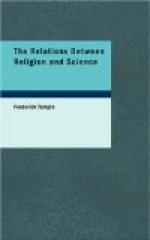But in the New Testament we stand on different ground. And we have here first the evidence which Paley has put together to show that the early Christians spent their lives and finally surrendered their lives as witnesses to a Gospel which included miracles both among its evidences and as part of its substance. It is not possible to get rid of miracles nor the belief in miracles from the history of the Apostles. They testify to our Lord’s Resurrection as to an actual fact, and make it the basis of all their preaching. They testify to our Lord’s miracles as part of the character of His life. It is necessary to maintain that they were mere fanatics with no claim to respect but rather to the pity which we feel for utterly ignorant goodness, if we are to hold that no miracle was ever wrought by our Lord. It is difficult to maintain even their honesty if they preached the Resurrection of our Lord without any basis of fact to rest on. No man who is not determined to uphold an opinion at all hazards can question that St. Paul and St. Peter believed that our Lord rose from the dead, and that they died for and in that belief.
But, in the second place, behind the Apostles stands our Lord Himself, and whatever may be said of the documents that compose the New Testament, they are at any rate sufficient to show that our Lord was universally believed by His disciples to have the power of working miracles and to have often worked them. There is no hesitation in regard to this; no hint of any doubt. But not only so, there is no hint of any disclaimer on His part. He must have known whether He could work miracles or not. He must have known that His disciples believed Him to possess the power. There is not the slightest trace of His ever having implied that this was a misconception. He did sometimes disclaim what was ascribed to Him, even when what was ascribed to Him was truly His, but was ascribed to Him without real knowledge of what it implied. ’Why callest thou Me good? There is none good but One, that is, God,’ we DO find. But ’Why askest thou Me to do this? There is none that can do this but One, that is God,’ we do NOT find. It is plain that He accepted the belief that assigned Him powers above those of other men—powers given Him by His Father in heaven—and never discouraged it. Nay, He demanded it. Take the lowest ground, and admit for argument’s sake that the New Testament contains a legendary element, and still you cannot cut the miracles out of the Gospels and Epistles without altering them beyond recognition. The Jesus Christ presented to us in the New Testament would become a different person if the miracles were removed. And if He claimed to possess and exercise this power, the evidence becomes the evidence of One Who must have known and Whom we cannot disbelieve.




